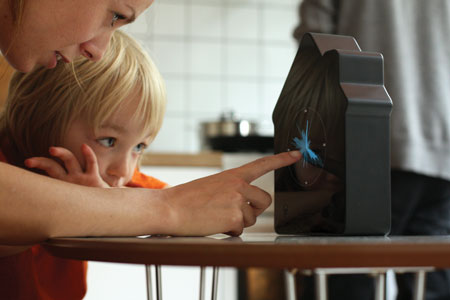by Christina Öhman
The development of new solutions for better energy use often starts with technology rather than the perspective of the user. Researchers at the Interactive Institute in Sweden do the opposite and look at design which supports awareness and behavioural changes – both important factors with high potentials.
Interactive Institute is an experimental IT research institute which combines expertise in art, design and information technology with a user-oriented focus. Several projects in the area of energy and design have generated results that are acknowledged worldwide.
Energy is an increasingly valuable resource. However, in the design of everyday domestic environments, buildings and products, electricity and energy use is seldom made explicit. On the contrary, wiring, electrical meters, outlets and batteries are hidden away as much as possible inside walls, in elegant casings and in distant basements. The trend is to fill the home with smart technology and appliances for communication and entertainment with no concerns in relation to energy. How can consumers become more engaged and less wasteful in this environment? We think the answer lies in design that makes energy use visible in an attractive fashion!
The overall goal in our projects is to empower people in their use of products and services by increasing the visibility of choices available to them and providing them with immediate feedback. In such studies, researchers explore users’ behaviour, attitudes and lifestyles in relation to energy use.
“Today most arrangements are focused on technology. But actually, the user is more interesting! The potential is tremendous if we can act, buy and support energy smart,” states Kenneth Asp, specialist at the Swedish Agency of Energy which supports the research of Interactive Institute. “A multidisciplinary approach with a human perspective is needed in order to develop new and better technology design. Engineers, architects, behavioural scientists and designers are working together. Prototypes and scenarios of various use concepts are evaluated by users and designers, to develop a profound understanding for, and awareness of, design issues related to energy use.”
 The ‘Energy Aware Clock’ gives intuitive feedback on the electricity load of the house.
The ‘Energy Aware Clock’ gives intuitive feedback on the electricity load of the house.
Projects in this area at the Interactive Institute cover energy studies relating to teenagers, products, neighbourhoods, social status, mobile phones and competition. The most widely published and acknowledged project is Static!. This project developed ways of experiencing energy that involve all the senses, allowing people to reflect on their energy use and behaviour by creating alternative designs that in various ways expose and provoke questions related to energy. The studies have resulted in a series of examples of how everyday products may be designed to stimulate reflection on daily or long-term patterns of energy use. For example, the ‘Power-Aware Cord’ is an electrical power strip in which the cord is designed to show the energy rather than hiding it. The more energy that passes through the cord, the more it glows! It is beautiful and it is a constant reminder that energy is being spent. Another example is bathroom tiles which are decorated with patterns in a thermo-chromatic ink that reflects hot-water use by fading away when hot water is splashed on it. The ‘Energy-Aware Clock’ centrally placed in the kitchen gives intuitive feedback on the electricity load of the house. The clock draws a graphic pattern in real time comparable to yesterday’s use.
The plan for future extended studies is to look further into behaviour at work and in shops. In these spaces people report that they need help to reflect on their environmental impact. We know that both consumers and companies are interested in services and tools that help to decrease emission, energy use and ecological footprints. We believe user-oriented design and interaction designs have great potential for such applications.
Links:
http://www.tii.se/static
http://www.tii.se/energydesign
http://www.tii.se/dru
Please contact:
Christina Öhman
Interactive Institute, Sweden
Tel: +46 8 6331751
E-mail:










